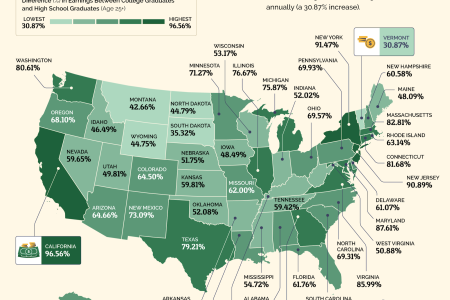The app market is booming, and with millions of apps available in different app stores, it’s important to ensure that yours stands out from the rest. But how can you make money from your app?
In this article, we’ll discuss three app monetization strategies that can help you generate revenue from your app. We will particularly emphasize in-app purchases as they are now considered one of the main monetization strategies, with in-app purchase examples in popular applications.
Related: How to Make Money With Your App: 5 Monetization Strategies To Try
In-app advertising
When it comes to in-app advertising, there are several different types to choose from. This includes banner ads, interstitial ads and native ads. However, it’s important to consider using non-intrusive ads to maintain a positive user experience. These types of ads can include sponsored content such as texts, photos or videos. The content you post in your ad campaign must be visually appealing but not aggravating so that it doesn’t cause any cases of user frustration. It is also important that you make sure that the ad you choose fits seamlessly within the app’s interface and looks neat.
Types of in-app advertising
1. Banner ads:
Banner ads are the most common type of in-app advertising. It usually comes in a rectangular form and is placed at either the top or bottom of the screen. A banner ad usually doesn’t contain many words or text; it depends instead on pictures and visuals that are able to deliver the ad’s value.
2. Native ads:
Native ads function exactly as their name suggests. They are employed to be viewed natively so as to match and blend in with the app’s interface. One of the benefits of native ads is that they tend to perform better than traditional banner ads. Users are more likely to interact with a native ad because it doesn’t feel like an advertisement. Native ads are thought to be the least intrusive type of ads. They are also very efficient, as you can control where they appear to users and how frequently.
3. Interstitial ads:
Interstitial ads are a common form of in-app advertising. They are full-screen ads that appear at natural breaks in the user’s flow, such as when transitioning between different sections of an app. Unlike banner ads, which are small and can be easily ignored, interstitial ads are highly visible and require the user to interact with them in some way, either by clicking on the ad or by dismissing it. While interstitial ads can be effective at generating revenue for app developers, they can also be a source of frustration for users if they are too frequent or disruptive. To avoid this, developers need to carefully balance the frequency and placement of interstitial ads.
Related: How Can App Makers Improve Revenue and Keep Users Engaged?
Subscription models
Subscription models have become increasingly popular among app developers as a monetization strategy for their services. These subscription models are designed to create a steady stream of recurring revenue for developers, enabling them to provide consistent updates and improvements to their apps. There are several different types of subscription models that developers can choose from, each with its own unique approach to generating revenue.
Types of subscription models
1. Freemium model:
The first and most popular model is the freemium model. With the freemium model, users can download and use the app for free, but they are limited in terms of features and functionality. To unlock the full range of features, users must pay for a subscription. An example of an app that uses such a model is Spotify. Spotify allows all users to access an unlimited library of music and podcasts. However, users of the free plan have some limited functionalities, such as limited skips per playlist and interrupting ads between songs.
2. Tiered model:
Another type is the tiered subscription model. This model offers users different levels of access to the app based on how much they pay. For example, a basic subscription might provide access to the app’s core features. Meanwhile, a premium subscription might offer additional functionality and perks. A popular app that uses such a model is Flo.
Related: Do You Want To Monetize Your App? Here’s What You Need To Consider
In-app purchases
One of the most popular and effective app monetization strategies nowadays is in-app purchases. This strategy has been gaining recognition and dominating the market. It is commonly used in ecommerce apps and gaming apps. In-app purchases are additional features or content that users can buy within an app. They can include virtual goods, additional or premium content, or extra functionality. In-app purchases are typically made through a user’s app store account. They can purchase whatever the app’s currency is and use it around the app for whatever they need.
In-app purchases are a popular way for app developers to monetize their products. By offering additional features, content or functionality, developers can provide a high-quality user experience while generating revenue. Developers should make the costs and benefits of in-app purchases clear to customers while also providing them with relevant and useful solutions.
In-app purchase examples
There are several different types of in-app purchases that app developers can offer to their users. Here are a few in-app purchase examples:
1. Consumables:
Consumables are virtual goods that users can use or consume. For example, in a game, a consumable might be a virtual currency that can be used to purchase items or upgrades within the game. Once the currency has been used up, the user must purchase more to continue using it.
2. Non-consumables:
Non-consumables are virtual goods that do not expire or get used up. For example, in a productivity app, a non-consumable in-app purchase might be a premium feature that unlocks additional functionality.
3. Subscriptions:
Subscriptions are another in-app purchase example that provides users with access to premium content or features for a set period of time. For example, a news app like Forbes or BBC News might offer a subscription that provides access to exclusive articles. This subscription can be non-renewable or auto-renewable.
Creating a successful app is not just about developing a great one; it’s also about finding effective ways to monetize it. In-app advertising, in-app purchases, and the subscription model are three app monetization strategies that can help you generate revenue from your app. It’s important to choose the strategy that best fits your app and your target audience.
Read the full article here









